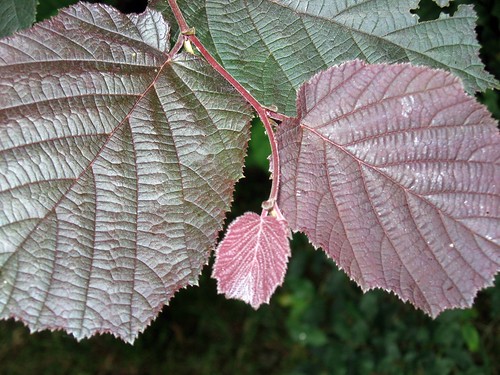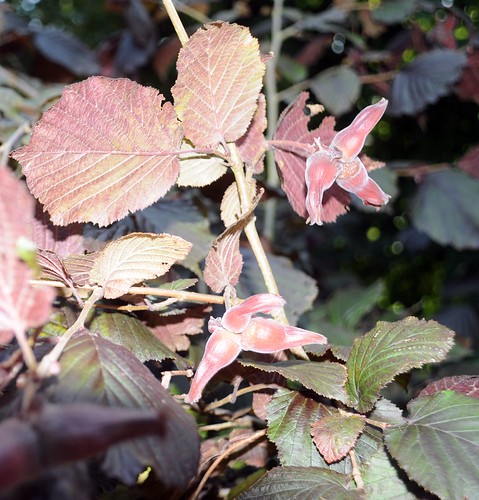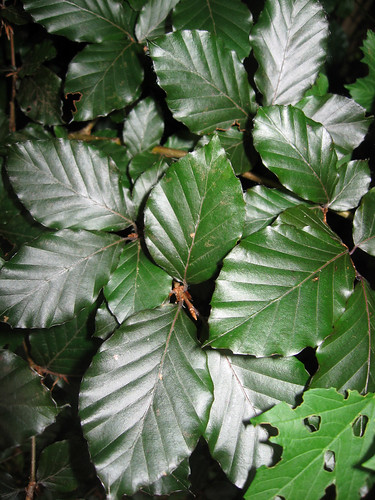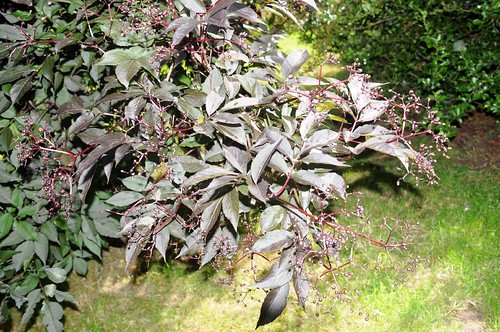I mentioned in the first hedge post that I'd love to do a few more hedges and one I've been pondering is an all purple hedge. I mentioned we whacked in a lot of hazel early doors but that wasn't the only member of the genus Corylus to go in. These are the (awesome) leaves of the Purple filbert (sold as either Corylus maxima purpurea or, more properly as, Corylus maxima "Red Zellernus"), the filbert being a south european species that is, for our purposes, almost identical to hazel.
Despite the odd colouration this is still a strong plant and will fend for itself in the hedge environment pretty well. It has a lot of the advantages of hazel, it responds well to pruning, produces big, lush, attractive leaves that various insects will go for and brilliantly it even produces nuts – purple nuts!
Purple filbert tends to be used as a specimen type shrub in gardens as opposed to hedges but will often produce a ring of either seedlings and/or suckers around the main plant. All our plants have come as chunks dug up from a friend's border or from around our own subsequent plants and we now have 4 or 5 kicking around and a load of our small plants potted up ready for deployment.
Probably the most famous purple hedging plant is the purple beech (above) which, as I mentioned in the last post, makes a fabulous, formal hedge. It is usually much more purple than this (especially with new growth) but these are old, shaded, leaves which have flushed green. Its perhaps worth mentioning that in addition to green and purple there are yellow and variegated forms of beech so for those so inclined a multicoloured stripey beech hedge is an option. Thus far the purple hedge would be distinctly lacking in berries. Not in our hedge but adjacent to it and sure to fit in are the purple elder (Sambucus nigra) cultivars. As with the hazel this is usually used as a standalone shrub but it will sucker well and is easily propagated so if you have (or a friend has) one you should be able to put together plenty to bulk out your purple hedge.
Assuming you don't collect the pink flowers to make what one would assume would be a rose elderflower champagne it will produce black berries beloved of all nature's creatures in autumn. Maybe don't plant this one to near to where you dry your washing/park your car.
This is the extent of the purple stuff I've got pictures of for now but if a purple hedge takes your fancy you may also want to consider the purple bird cherry (Prunus padus "Colorata"), the purple cherry plum (Prunus cerasifera vars. atropurpurea or nigra) or any of the purple-leaved crab apples (my own favourite being Malus "Royalty"), all of which will produce nectar rich flowers and later fruit whilst retaining the purple leaf motif.
This is the extent of the purple stuff I've got pictures of for now but if a purple hedge takes your fancy you may also want to consider the purple bird cherry (Prunus padus "Colorata"), the purple cherry plum (Prunus cerasifera vars. atropurpurea or nigra) or any of the purple-leaved crab apples (my own favourite being Malus "Royalty"), all of which will produce nectar rich flowers and later fruit whilst retaining the purple leaf motif.




2 comments:
Hedges serve as a fence between you and your neighbors. Planting a garden hedge can help to make your property look better and also can help keep out intruders. You should make sure that the height of the hedge is not more than 6 feet as this can block the sunlight to both you and your neighbor.
Post a Comment